Architectural Workplace Design & Employee Work Behaviors Review
VerifiedAdded on 2023/06/12
|7
|2044
|59
Literature Review
AI Summary
This literature review investigates the impact of architectural workplace designs and technology on employee work behaviors, drawing from a core article and related research. It addresses how architectural technology contributes to workspace redesign, the factors driving the architectural technology craze, the most suitable office space configurations for employee behaviors, and the challenges in redesigning workspaces. The review examines the shift towards innovative and collaborative spaces, the influence of technology and user input on design, and the pros and cons of various office layouts such as private offices, open offices, cubicles, and co-working spaces. Challenges such as balancing innovation with flexibility, adapting to changing work patterns, and effectively communicating tacit information in collaborative design are also discussed.
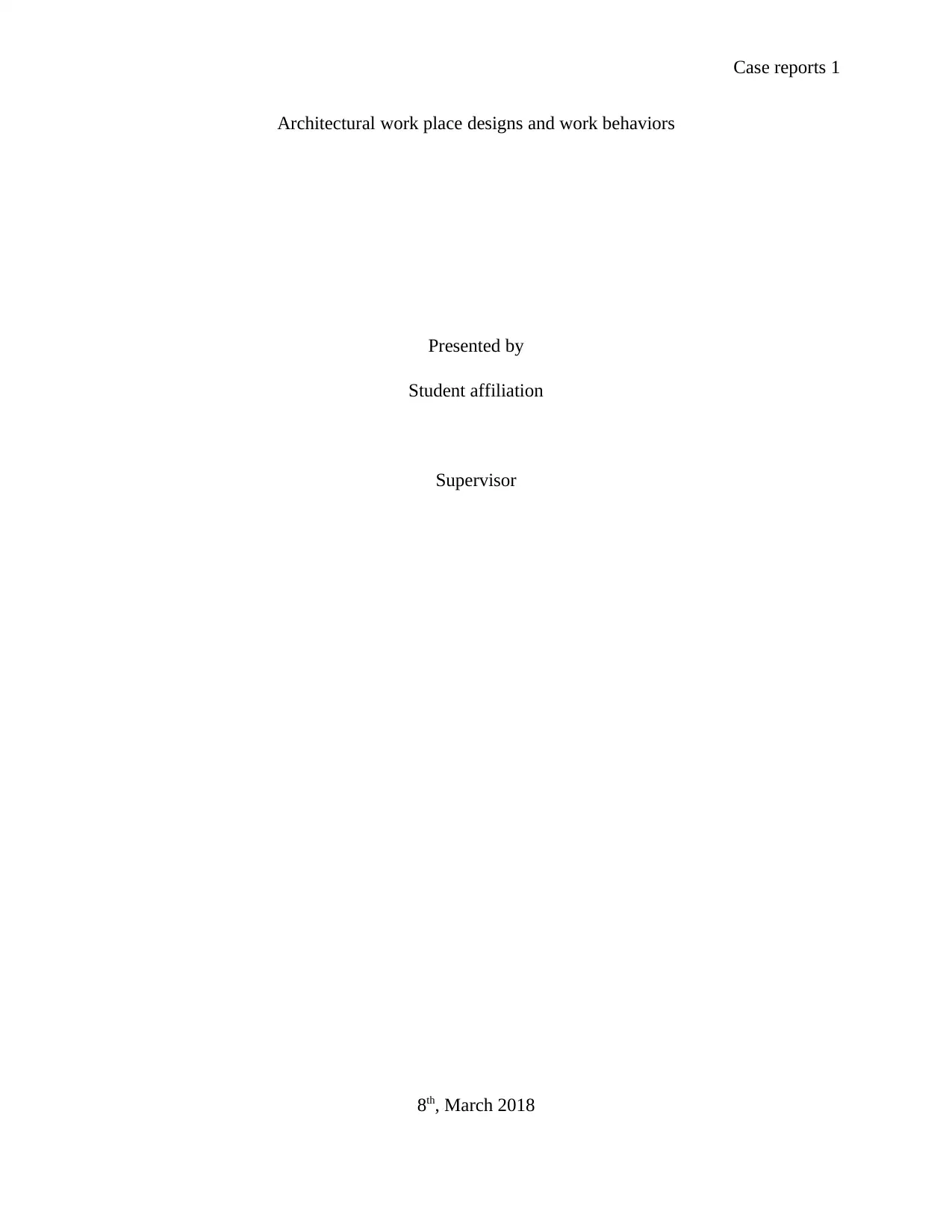
Case reports 1
Architectural work place designs and work behaviors
Presented by
Student affiliation
Supervisor
8th, March 2018
Architectural work place designs and work behaviors
Presented by
Student affiliation
Supervisor
8th, March 2018
Paraphrase This Document
Need a fresh take? Get an instant paraphrase of this document with our AI Paraphraser
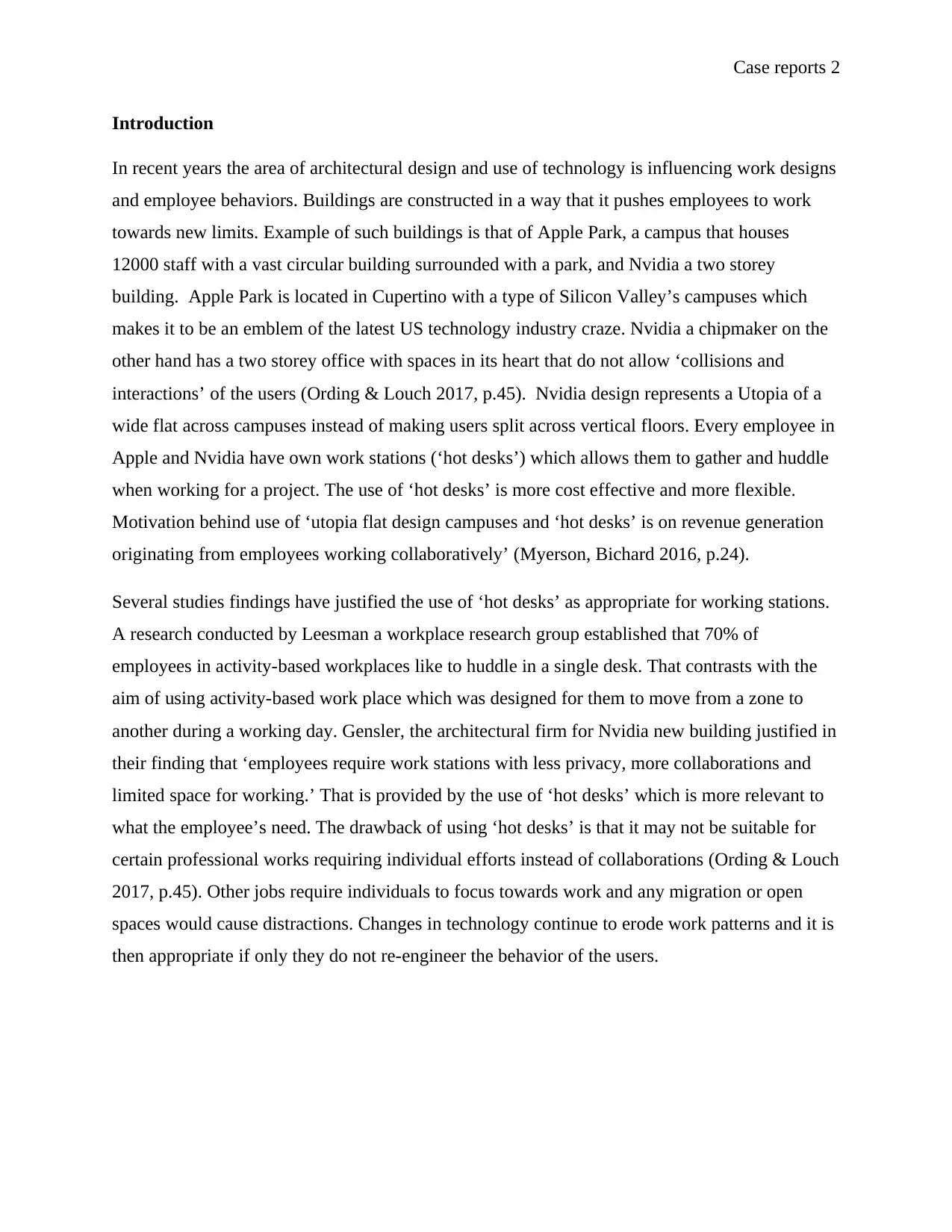
Case reports 2
Introduction
In recent years the area of architectural design and use of technology is influencing work designs
and employee behaviors. Buildings are constructed in a way that it pushes employees to work
towards new limits. Example of such buildings is that of Apple Park, a campus that houses
12000 staff with a vast circular building surrounded with a park, and Nvidia a two storey
building. Apple Park is located in Cupertino with a type of Silicon Valley’s campuses which
makes it to be an emblem of the latest US technology industry craze. Nvidia a chipmaker on the
other hand has a two storey office with spaces in its heart that do not allow ‘collisions and
interactions’ of the users (Ording & Louch 2017, p.45). Nvidia design represents a Utopia of a
wide flat across campuses instead of making users split across vertical floors. Every employee in
Apple and Nvidia have own work stations (‘hot desks’) which allows them to gather and huddle
when working for a project. The use of ‘hot desks’ is more cost effective and more flexible.
Motivation behind use of ‘utopia flat design campuses and ‘hot desks’ is on revenue generation
originating from employees working collaboratively’ (Myerson, Bichard 2016, p.24).
Several studies findings have justified the use of ‘hot desks’ as appropriate for working stations.
A research conducted by Leesman a workplace research group established that 70% of
employees in activity-based workplaces like to huddle in a single desk. That contrasts with the
aim of using activity-based work place which was designed for them to move from a zone to
another during a working day. Gensler, the architectural firm for Nvidia new building justified in
their finding that ‘employees require work stations with less privacy, more collaborations and
limited space for working.’ That is provided by the use of ‘hot desks’ which is more relevant to
what the employee’s need. The drawback of using ‘hot desks’ is that it may not be suitable for
certain professional works requiring individual efforts instead of collaborations (Ording & Louch
2017, p.45). Other jobs require individuals to focus towards work and any migration or open
spaces would cause distractions. Changes in technology continue to erode work patterns and it is
then appropriate if only they do not re-engineer the behavior of the users.
Introduction
In recent years the area of architectural design and use of technology is influencing work designs
and employee behaviors. Buildings are constructed in a way that it pushes employees to work
towards new limits. Example of such buildings is that of Apple Park, a campus that houses
12000 staff with a vast circular building surrounded with a park, and Nvidia a two storey
building. Apple Park is located in Cupertino with a type of Silicon Valley’s campuses which
makes it to be an emblem of the latest US technology industry craze. Nvidia a chipmaker on the
other hand has a two storey office with spaces in its heart that do not allow ‘collisions and
interactions’ of the users (Ording & Louch 2017, p.45). Nvidia design represents a Utopia of a
wide flat across campuses instead of making users split across vertical floors. Every employee in
Apple and Nvidia have own work stations (‘hot desks’) which allows them to gather and huddle
when working for a project. The use of ‘hot desks’ is more cost effective and more flexible.
Motivation behind use of ‘utopia flat design campuses and ‘hot desks’ is on revenue generation
originating from employees working collaboratively’ (Myerson, Bichard 2016, p.24).
Several studies findings have justified the use of ‘hot desks’ as appropriate for working stations.
A research conducted by Leesman a workplace research group established that 70% of
employees in activity-based workplaces like to huddle in a single desk. That contrasts with the
aim of using activity-based work place which was designed for them to move from a zone to
another during a working day. Gensler, the architectural firm for Nvidia new building justified in
their finding that ‘employees require work stations with less privacy, more collaborations and
limited space for working.’ That is provided by the use of ‘hot desks’ which is more relevant to
what the employee’s need. The drawback of using ‘hot desks’ is that it may not be suitable for
certain professional works requiring individual efforts instead of collaborations (Ording & Louch
2017, p.45). Other jobs require individuals to focus towards work and any migration or open
spaces would cause distractions. Changes in technology continue to erode work patterns and it is
then appropriate if only they do not re-engineer the behavior of the users.
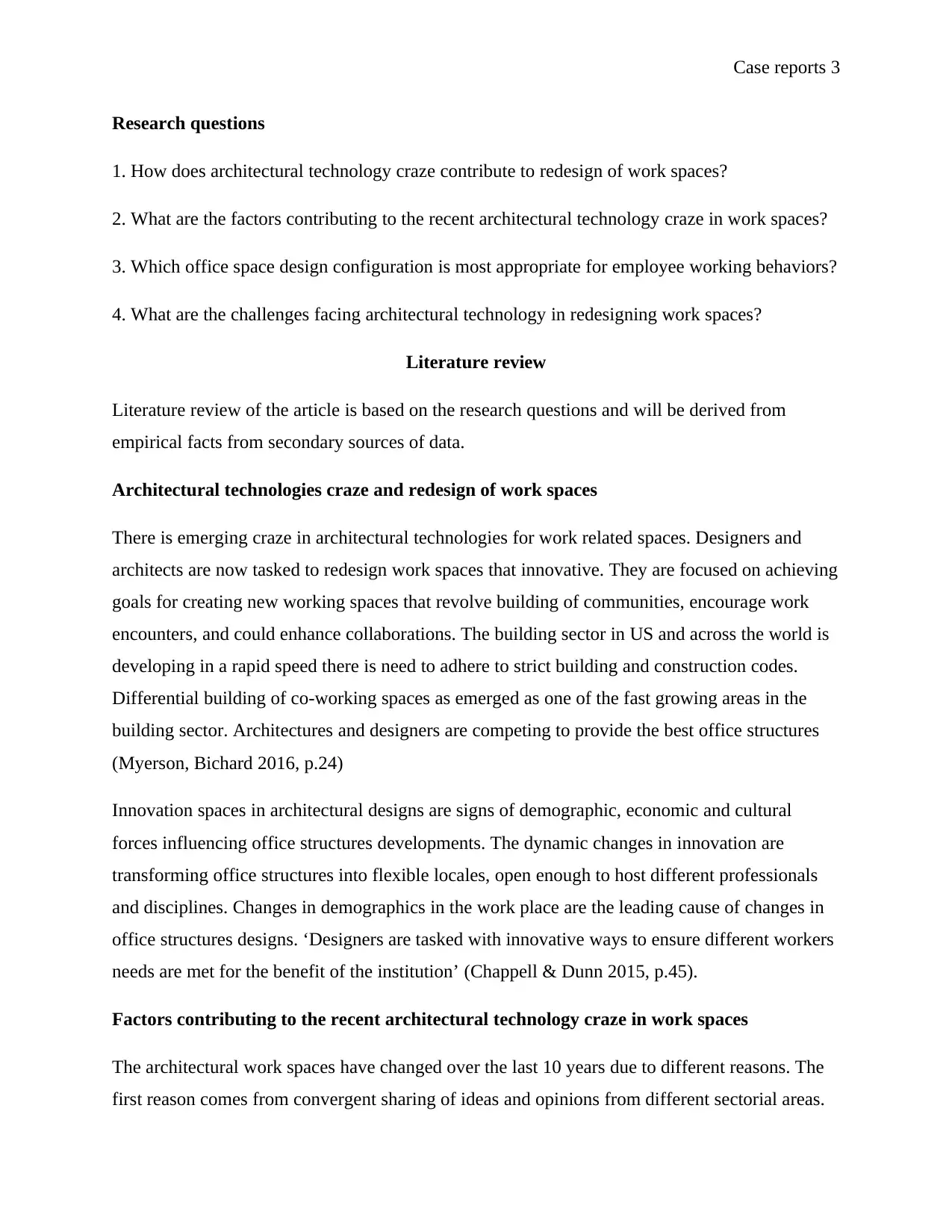
Case reports 3
Research questions
1. How does architectural technology craze contribute to redesign of work spaces?
2. What are the factors contributing to the recent architectural technology craze in work spaces?
3. Which office space design configuration is most appropriate for employee working behaviors?
4. What are the challenges facing architectural technology in redesigning work spaces?
Literature review
Literature review of the article is based on the research questions and will be derived from
empirical facts from secondary sources of data.
Architectural technologies craze and redesign of work spaces
There is emerging craze in architectural technologies for work related spaces. Designers and
architects are now tasked to redesign work spaces that innovative. They are focused on achieving
goals for creating new working spaces that revolve building of communities, encourage work
encounters, and could enhance collaborations. The building sector in US and across the world is
developing in a rapid speed there is need to adhere to strict building and construction codes.
Differential building of co-working spaces as emerged as one of the fast growing areas in the
building sector. Architectures and designers are competing to provide the best office structures
(Myerson, Bichard 2016, p.24)
Innovation spaces in architectural designs are signs of demographic, economic and cultural
forces influencing office structures developments. The dynamic changes in innovation are
transforming office structures into flexible locales, open enough to host different professionals
and disciplines. Changes in demographics in the work place are the leading cause of changes in
office structures designs. ‘Designers are tasked with innovative ways to ensure different workers
needs are met for the benefit of the institution’ (Chappell & Dunn 2015, p.45).
Factors contributing to the recent architectural technology craze in work spaces
The architectural work spaces have changed over the last 10 years due to different reasons. The
first reason comes from convergent sharing of ideas and opinions from different sectorial areas.
Research questions
1. How does architectural technology craze contribute to redesign of work spaces?
2. What are the factors contributing to the recent architectural technology craze in work spaces?
3. Which office space design configuration is most appropriate for employee working behaviors?
4. What are the challenges facing architectural technology in redesigning work spaces?
Literature review
Literature review of the article is based on the research questions and will be derived from
empirical facts from secondary sources of data.
Architectural technologies craze and redesign of work spaces
There is emerging craze in architectural technologies for work related spaces. Designers and
architects are now tasked to redesign work spaces that innovative. They are focused on achieving
goals for creating new working spaces that revolve building of communities, encourage work
encounters, and could enhance collaborations. The building sector in US and across the world is
developing in a rapid speed there is need to adhere to strict building and construction codes.
Differential building of co-working spaces as emerged as one of the fast growing areas in the
building sector. Architectures and designers are competing to provide the best office structures
(Myerson, Bichard 2016, p.24)
Innovation spaces in architectural designs are signs of demographic, economic and cultural
forces influencing office structures developments. The dynamic changes in innovation are
transforming office structures into flexible locales, open enough to host different professionals
and disciplines. Changes in demographics in the work place are the leading cause of changes in
office structures designs. ‘Designers are tasked with innovative ways to ensure different workers
needs are met for the benefit of the institution’ (Chappell & Dunn 2015, p.45).
Factors contributing to the recent architectural technology craze in work spaces
The architectural work spaces have changed over the last 10 years due to different reasons. The
first reason comes from convergent sharing of ideas and opinions from different sectorial areas.
⊘ This is a preview!⊘
Do you want full access?
Subscribe today to unlock all pages.

Trusted by 1+ million students worldwide
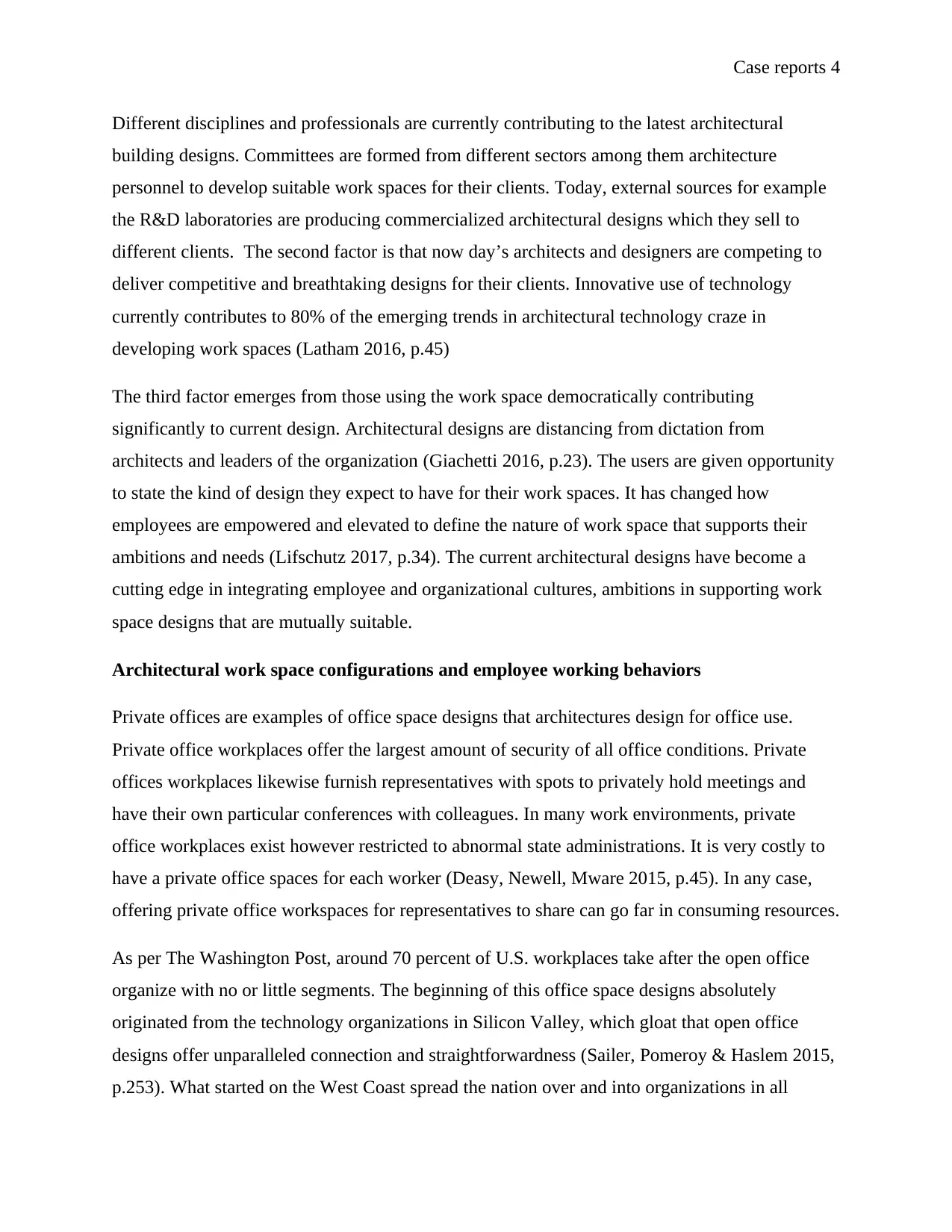
Case reports 4
Different disciplines and professionals are currently contributing to the latest architectural
building designs. Committees are formed from different sectors among them architecture
personnel to develop suitable work spaces for their clients. Today, external sources for example
the R&D laboratories are producing commercialized architectural designs which they sell to
different clients. The second factor is that now day’s architects and designers are competing to
deliver competitive and breathtaking designs for their clients. Innovative use of technology
currently contributes to 80% of the emerging trends in architectural technology craze in
developing work spaces (Latham 2016, p.45)
The third factor emerges from those using the work space democratically contributing
significantly to current design. Architectural designs are distancing from dictation from
architects and leaders of the organization (Giachetti 2016, p.23). The users are given opportunity
to state the kind of design they expect to have for their work spaces. It has changed how
employees are empowered and elevated to define the nature of work space that supports their
ambitions and needs (Lifschutz 2017, p.34). The current architectural designs have become a
cutting edge in integrating employee and organizational cultures, ambitions in supporting work
space designs that are mutually suitable.
Architectural work space configurations and employee working behaviors
Private offices are examples of office space designs that architectures design for office use.
Private office workplaces offer the largest amount of security of all office conditions. Private
offices workplaces likewise furnish representatives with spots to privately hold meetings and
have their own particular conferences with colleagues. In many work environments, private
office workplaces exist however restricted to abnormal state administrations. It is very costly to
have a private office spaces for each worker (Deasy, Newell, Mware 2015, p.45). In any case,
offering private office workspaces for representatives to share can go far in consuming resources.
As per The Washington Post, around 70 percent of U.S. workplaces take after the open office
organize with no or little segments. The beginning of this office space designs absolutely
originated from the technology organizations in Silicon Valley, which gloat that open office
designs offer unparalleled connection and straightforwardness (Sailer, Pomeroy & Haslem 2015,
p.253). What started on the West Coast spread the nation over and into organizations in all
Different disciplines and professionals are currently contributing to the latest architectural
building designs. Committees are formed from different sectors among them architecture
personnel to develop suitable work spaces for their clients. Today, external sources for example
the R&D laboratories are producing commercialized architectural designs which they sell to
different clients. The second factor is that now day’s architects and designers are competing to
deliver competitive and breathtaking designs for their clients. Innovative use of technology
currently contributes to 80% of the emerging trends in architectural technology craze in
developing work spaces (Latham 2016, p.45)
The third factor emerges from those using the work space democratically contributing
significantly to current design. Architectural designs are distancing from dictation from
architects and leaders of the organization (Giachetti 2016, p.23). The users are given opportunity
to state the kind of design they expect to have for their work spaces. It has changed how
employees are empowered and elevated to define the nature of work space that supports their
ambitions and needs (Lifschutz 2017, p.34). The current architectural designs have become a
cutting edge in integrating employee and organizational cultures, ambitions in supporting work
space designs that are mutually suitable.
Architectural work space configurations and employee working behaviors
Private offices are examples of office space designs that architectures design for office use.
Private office workplaces offer the largest amount of security of all office conditions. Private
offices workplaces likewise furnish representatives with spots to privately hold meetings and
have their own particular conferences with colleagues. In many work environments, private
office workplaces exist however restricted to abnormal state administrations. It is very costly to
have a private office spaces for each worker (Deasy, Newell, Mware 2015, p.45). In any case,
offering private office workspaces for representatives to share can go far in consuming resources.
As per The Washington Post, around 70 percent of U.S. workplaces take after the open office
organize with no or little segments. The beginning of this office space designs absolutely
originated from the technology organizations in Silicon Valley, which gloat that open office
designs offer unparalleled connection and straightforwardness (Sailer, Pomeroy & Haslem 2015,
p.253). What started on the West Coast spread the nation over and into organizations in all
Paraphrase This Document
Need a fresh take? Get an instant paraphrase of this document with our AI Paraphraser
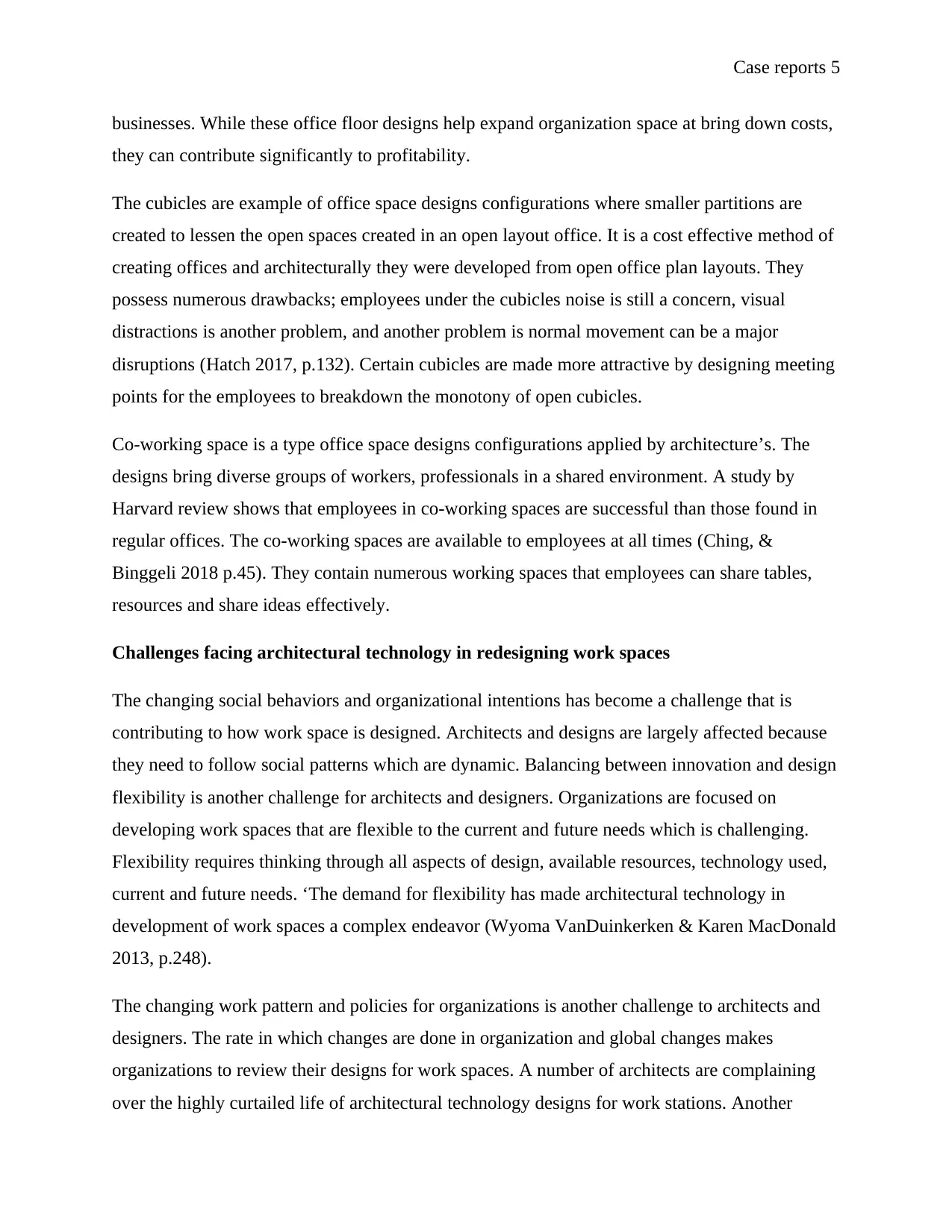
Case reports 5
businesses. While these office floor designs help expand organization space at bring down costs,
they can contribute significantly to profitability.
The cubicles are example of office space designs configurations where smaller partitions are
created to lessen the open spaces created in an open layout office. It is a cost effective method of
creating offices and architecturally they were developed from open office plan layouts. They
possess numerous drawbacks; employees under the cubicles noise is still a concern, visual
distractions is another problem, and another problem is normal movement can be a major
disruptions (Hatch 2017, p.132). Certain cubicles are made more attractive by designing meeting
points for the employees to breakdown the monotony of open cubicles.
Co-working space is a type office space designs configurations applied by architecture’s. The
designs bring diverse groups of workers, professionals in a shared environment. A study by
Harvard review shows that employees in co-working spaces are successful than those found in
regular offices. The co-working spaces are available to employees at all times (Ching, &
Binggeli 2018 p.45). They contain numerous working spaces that employees can share tables,
resources and share ideas effectively.
Challenges facing architectural technology in redesigning work spaces
The changing social behaviors and organizational intentions has become a challenge that is
contributing to how work space is designed. Architects and designs are largely affected because
they need to follow social patterns which are dynamic. Balancing between innovation and design
flexibility is another challenge for architects and designers. Organizations are focused on
developing work spaces that are flexible to the current and future needs which is challenging.
Flexibility requires thinking through all aspects of design, available resources, technology used,
current and future needs. ‘The demand for flexibility has made architectural technology in
development of work spaces a complex endeavor (Wyoma VanDuinkerken & Karen MacDonald
2013, p.248).
The changing work pattern and policies for organizations is another challenge to architects and
designers. The rate in which changes are done in organization and global changes makes
organizations to review their designs for work spaces. A number of architects are complaining
over the highly curtailed life of architectural technology designs for work stations. Another
businesses. While these office floor designs help expand organization space at bring down costs,
they can contribute significantly to profitability.
The cubicles are example of office space designs configurations where smaller partitions are
created to lessen the open spaces created in an open layout office. It is a cost effective method of
creating offices and architecturally they were developed from open office plan layouts. They
possess numerous drawbacks; employees under the cubicles noise is still a concern, visual
distractions is another problem, and another problem is normal movement can be a major
disruptions (Hatch 2017, p.132). Certain cubicles are made more attractive by designing meeting
points for the employees to breakdown the monotony of open cubicles.
Co-working space is a type office space designs configurations applied by architecture’s. The
designs bring diverse groups of workers, professionals in a shared environment. A study by
Harvard review shows that employees in co-working spaces are successful than those found in
regular offices. The co-working spaces are available to employees at all times (Ching, &
Binggeli 2018 p.45). They contain numerous working spaces that employees can share tables,
resources and share ideas effectively.
Challenges facing architectural technology in redesigning work spaces
The changing social behaviors and organizational intentions has become a challenge that is
contributing to how work space is designed. Architects and designs are largely affected because
they need to follow social patterns which are dynamic. Balancing between innovation and design
flexibility is another challenge for architects and designers. Organizations are focused on
developing work spaces that are flexible to the current and future needs which is challenging.
Flexibility requires thinking through all aspects of design, available resources, technology used,
current and future needs. ‘The demand for flexibility has made architectural technology in
development of work spaces a complex endeavor (Wyoma VanDuinkerken & Karen MacDonald
2013, p.248).
The changing work pattern and policies for organizations is another challenge to architects and
designers. The rate in which changes are done in organization and global changes makes
organizations to review their designs for work spaces. A number of architects are complaining
over the highly curtailed life of architectural technology designs for work stations. Another
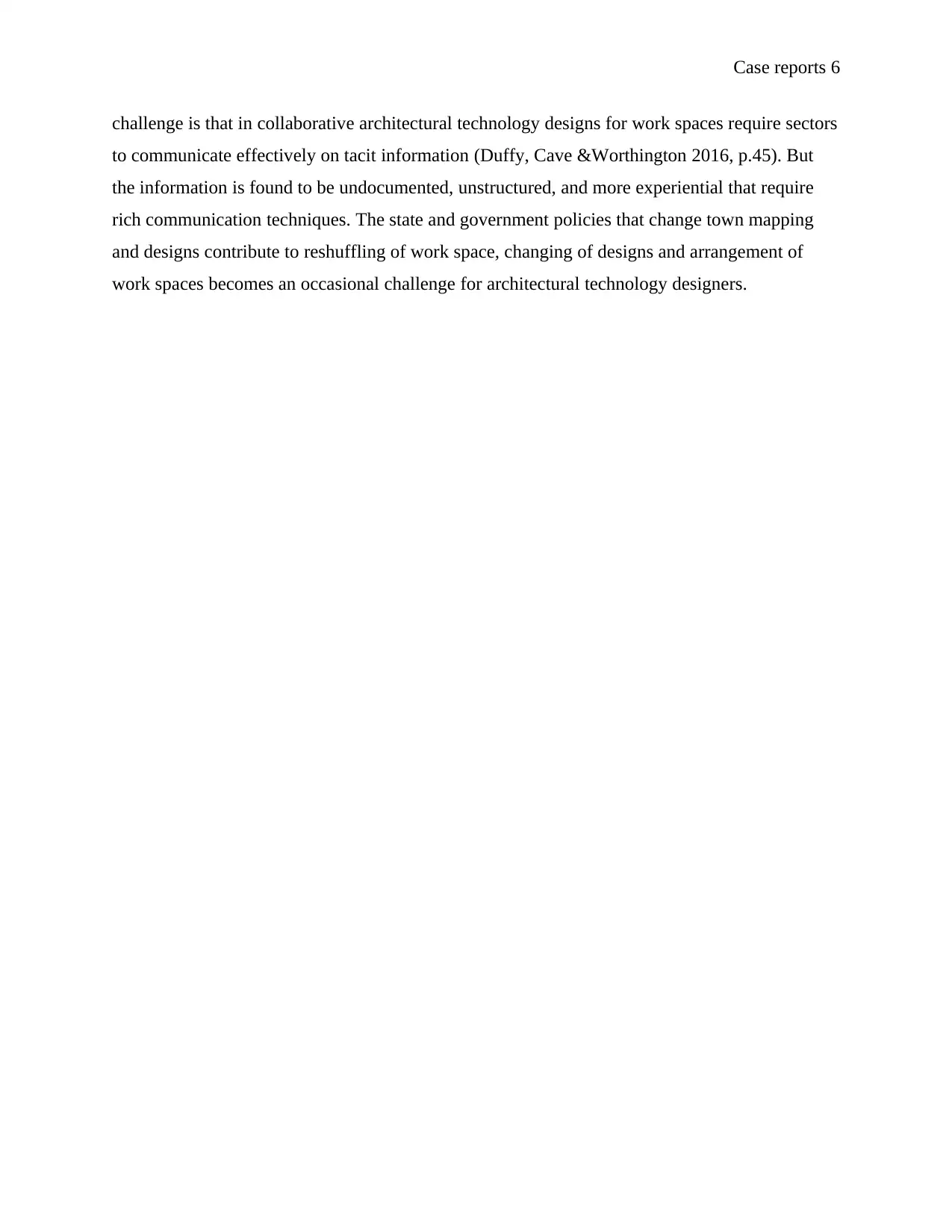
Case reports 6
challenge is that in collaborative architectural technology designs for work spaces require sectors
to communicate effectively on tacit information (Duffy, Cave &Worthington 2016, p.45). But
the information is found to be undocumented, unstructured, and more experiential that require
rich communication techniques. The state and government policies that change town mapping
and designs contribute to reshuffling of work space, changing of designs and arrangement of
work spaces becomes an occasional challenge for architectural technology designers.
challenge is that in collaborative architectural technology designs for work spaces require sectors
to communicate effectively on tacit information (Duffy, Cave &Worthington 2016, p.45). But
the information is found to be undocumented, unstructured, and more experiential that require
rich communication techniques. The state and government policies that change town mapping
and designs contribute to reshuffling of work space, changing of designs and arrangement of
work spaces becomes an occasional challenge for architectural technology designers.
⊘ This is a preview!⊘
Do you want full access?
Subscribe today to unlock all pages.

Trusted by 1+ million students worldwide
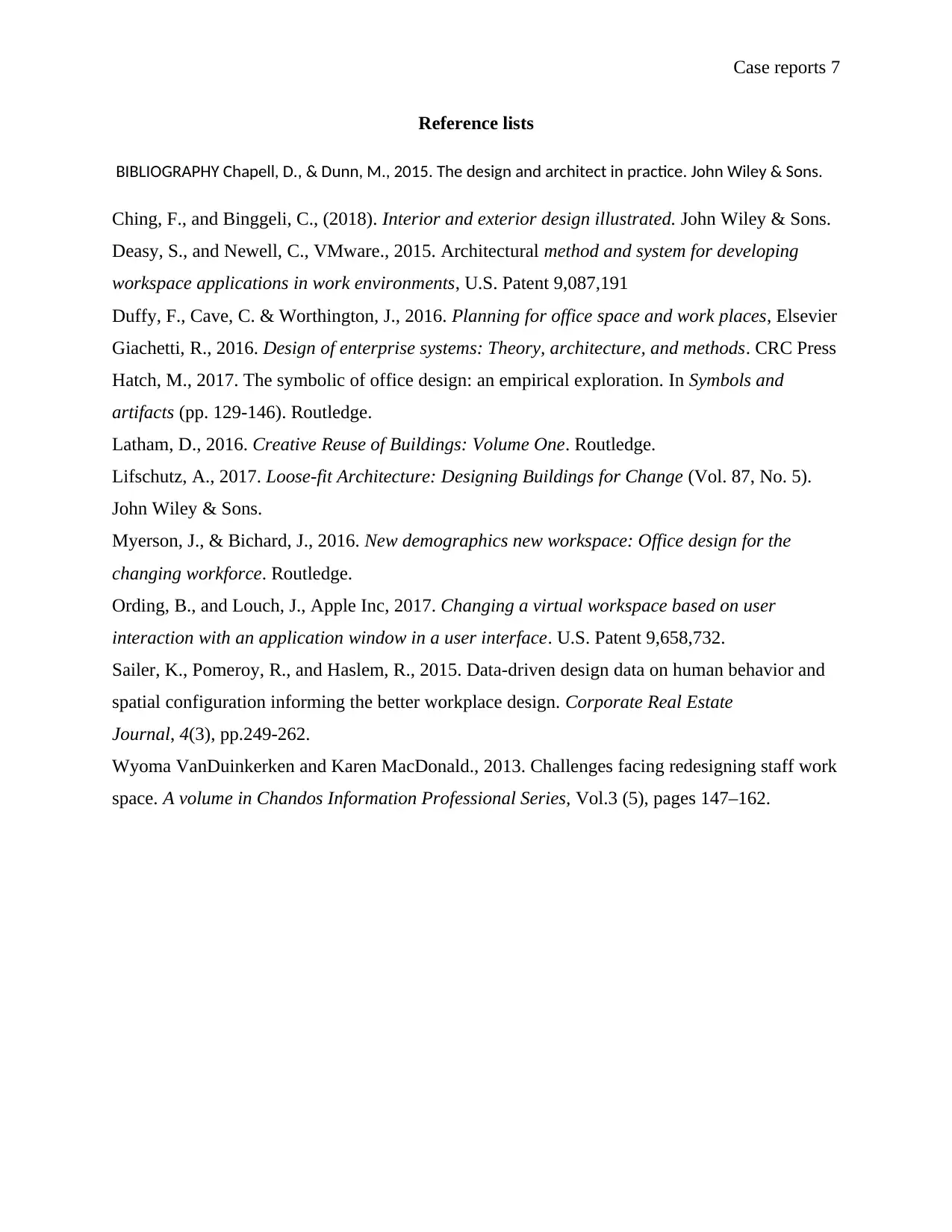
Case reports 7
Reference lists
BIBLIOGRAPHY Chapell, D., & Dunn, M., 2015. The design and architect in practice. John Wiley & Sons.
Ching, F., and Binggeli, C., (2018). Interior and exterior design illustrated. John Wiley & Sons.
Deasy, S., and Newell, C., VMware., 2015. Architectural method and system for developing
workspace applications in work environments, U.S. Patent 9,087,191
Duffy, F., Cave, C. & Worthington, J., 2016. Planning for office space and work places, Elsevier
Giachetti, R., 2016. Design of enterprise systems: Theory, architecture, and methods. CRC Press
Hatch, M., 2017. The symbolic of office design: an empirical exploration. In Symbols and
artifacts (pp. 129-146). Routledge.
Latham, D., 2016. Creative Reuse of Buildings: Volume One. Routledge.
Lifschutz, A., 2017. Loose-fit Architecture: Designing Buildings for Change (Vol. 87, No. 5).
John Wiley & Sons.
Myerson, J., & Bichard, J., 2016. New demographics new workspace: Office design for the
changing workforce. Routledge.
Ording, B., and Louch, J., Apple Inc, 2017. Changing a virtual workspace based on user
interaction with an application window in a user interface. U.S. Patent 9,658,732.
Sailer, K., Pomeroy, R., and Haslem, R., 2015. Data-driven design data on human behavior and
spatial configuration informing the better workplace design. Corporate Real Estate
Journal, 4(3), pp.249-262.
Wyoma VanDuinkerken and Karen MacDonald., 2013. Challenges facing redesigning staff work
space. A volume in Chandos Information Professional Series, Vol.3 (5), pages 147–162.
Reference lists
BIBLIOGRAPHY Chapell, D., & Dunn, M., 2015. The design and architect in practice. John Wiley & Sons.
Ching, F., and Binggeli, C., (2018). Interior and exterior design illustrated. John Wiley & Sons.
Deasy, S., and Newell, C., VMware., 2015. Architectural method and system for developing
workspace applications in work environments, U.S. Patent 9,087,191
Duffy, F., Cave, C. & Worthington, J., 2016. Planning for office space and work places, Elsevier
Giachetti, R., 2016. Design of enterprise systems: Theory, architecture, and methods. CRC Press
Hatch, M., 2017. The symbolic of office design: an empirical exploration. In Symbols and
artifacts (pp. 129-146). Routledge.
Latham, D., 2016. Creative Reuse of Buildings: Volume One. Routledge.
Lifschutz, A., 2017. Loose-fit Architecture: Designing Buildings for Change (Vol. 87, No. 5).
John Wiley & Sons.
Myerson, J., & Bichard, J., 2016. New demographics new workspace: Office design for the
changing workforce. Routledge.
Ording, B., and Louch, J., Apple Inc, 2017. Changing a virtual workspace based on user
interaction with an application window in a user interface. U.S. Patent 9,658,732.
Sailer, K., Pomeroy, R., and Haslem, R., 2015. Data-driven design data on human behavior and
spatial configuration informing the better workplace design. Corporate Real Estate
Journal, 4(3), pp.249-262.
Wyoma VanDuinkerken and Karen MacDonald., 2013. Challenges facing redesigning staff work
space. A volume in Chandos Information Professional Series, Vol.3 (5), pages 147–162.
1 out of 7
Your All-in-One AI-Powered Toolkit for Academic Success.
+13062052269
info@desklib.com
Available 24*7 on WhatsApp / Email
![[object Object]](/_next/static/media/star-bottom.7253800d.svg)
Unlock your academic potential
Copyright © 2020–2025 A2Z Services. All Rights Reserved. Developed and managed by ZUCOL.

